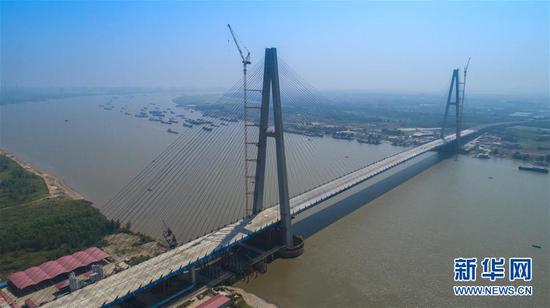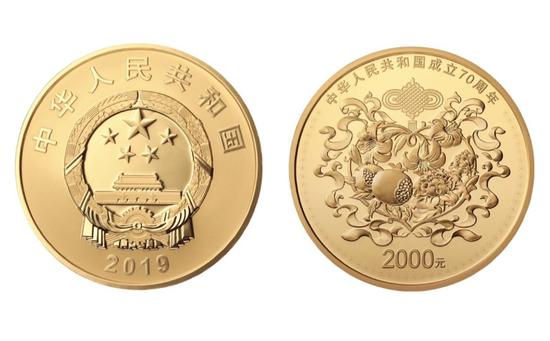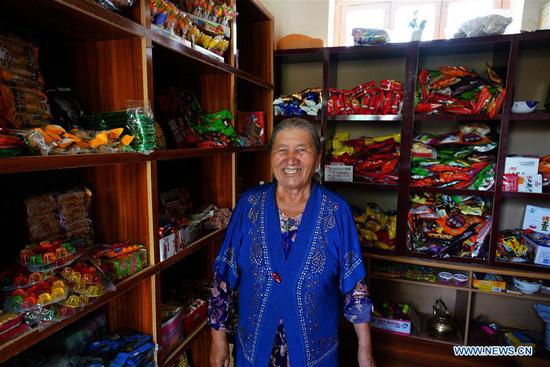
A truck arrives for cargo loading and unloading at the Port of Lianyungang, Jiangsu Province, on Sept. 8. (Photo by Wang Chun/For China Daily)
China's foreign trade will continue to show strong resilience for the rest of the year, boosted by its fast-growing private sector, and diversified export and import channels with partners participating in the Belt and Road Initiative, business leaders said on Monday.
They made the remarks after the General Administration of Customs announced that the total value of Chinese imports and exports of goods rose 3.6 percent year-on-year to 20.13 trillion yuan ($2.82 trillion) in the first eight months of the year. Its trade surplus stood at 239.6 billion yuan last month, expanding 41.8 percent from a year earlier.
The global economic uncertainty caused by protectionism has pushed China to raise its trade activities with countries such as Germany, France, Russia, South Korea and Japan to further tap their cooperation potential in areas such as high-tech, innovation, agriculture, finance and digital economy, said Liu Yuan, a researcher at the Research Institute for Global Value Chains at the University of International Business and Economics.
The European Union remained China's largest trading partner during the period, with bilateral trade volume up 9.7 percent from a year earlier to 3.15 trillion yuan, followed by the Association of Southeast Asian Nations, up 11.7 percent to 2.74 trillion yuan, and the United States, down 9 percent to 2.42 trillion yuan.
China's trade with countries and regions participating in the Belt and Road Initiative totaled 5.83 trillion yuan for the January-August period, up 9.9 percent year-on-year, 6.3 percentage points higher than the overall pace, said the GAC, adding that the amount accounted for 29 percent of China's total trade volume.
In the meantime, the country's trade with Saudi Arabia, Poland and Uzbekistan jumped 36.3 percent, 22.2 percent and 23.6 percent year-on-year, respectively.
Tim Smith, the Asia-Pacific head of APM Terminals - the port and terminal operating arm of Denmark's Maersk Group, said with surging infrastructure development and job opportunities, the BRI is the future global economic growth engine, and that shipping port operators and logistics companies will benefit through cooperation and trade activities brought by the initiative.
Confronting downward pressure and headwinds from Sino-US trade frictions, the government vowed to take further steps to ensure the stability of employment, the financial sector, foreign trade, foreign investment, domestic investment and expectations, according to a statement released after a State Council executive meeting last week.
Wu Xiangong, vice-president of China National Chemical Engineering Group Corp, said many BRI related economies' demand for upgrading existing infrastructure facilities and the accelerating pace of urbanization will not only boost China's exports to these markets, but also increase foreign companies' revenue growth across the world. It is a win-win situation.
"Many products shipped to overseas markets were made by multinational companies' factories in China," he said, adding that for global manufacturing business, China has a reliable labor force, and an advanced e-commerce based sales platforms and logistics network in comparison with other emerging markets.
Lothar Herrmann, president and CEO of Siemens China, said the German company has partnered with over 100 Chinese firms in both private and State-owned sectors to serve more than 100 markets across the world with its business network and industrial expertise, as well as its accumulated knowledge of the local customs and legal environment.
Apart from enlarging market channels related to the BRI, the imports and exports of private companies soared 11.2 percent year-on-year to 8.49 trillion yuan between January and August, accounting for 42.2 percent of the total value of China's foreign trade, about 7.6 percentage points higher than the overall growth rate of China's foreign trade in the same period, according to the GAC data.


















































